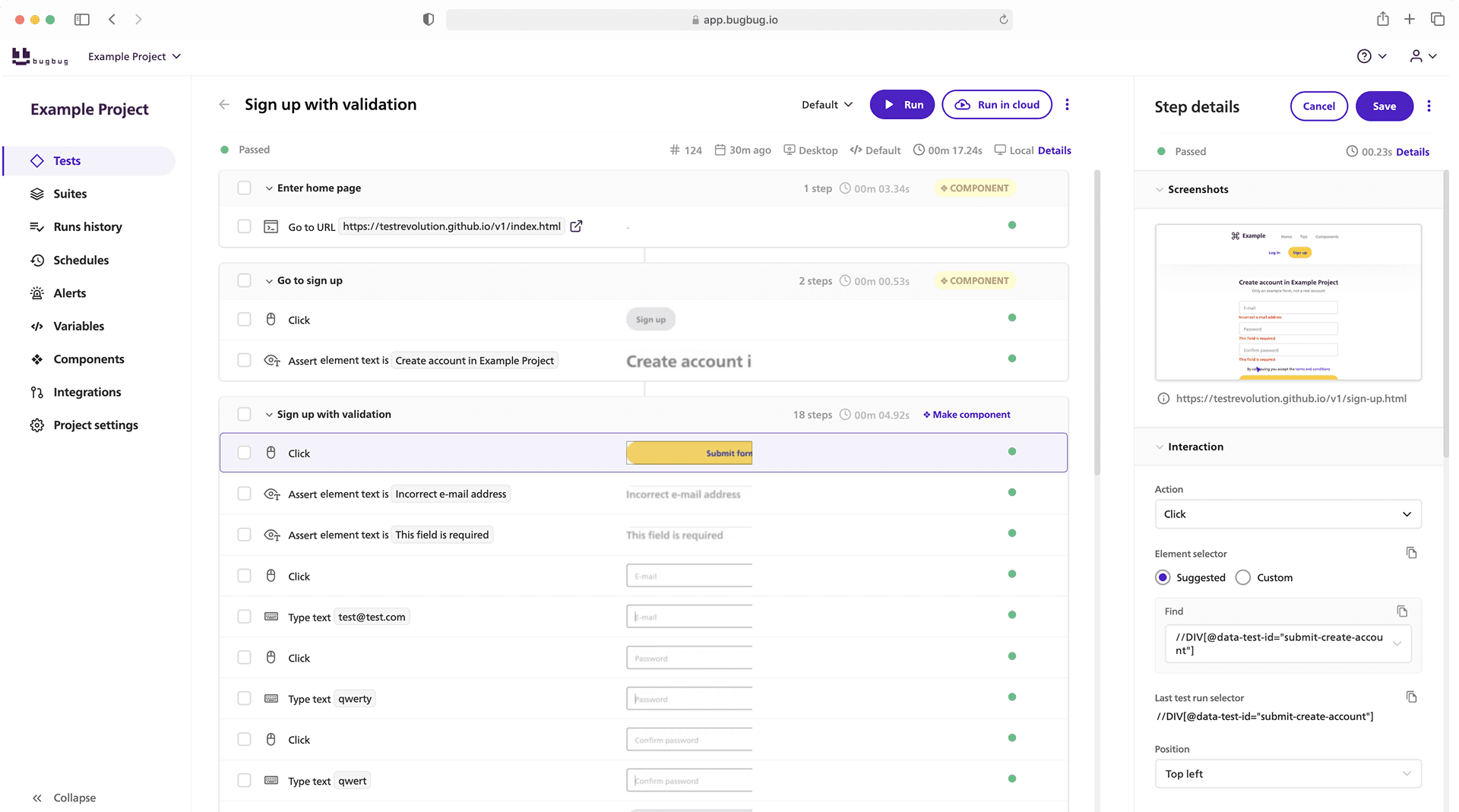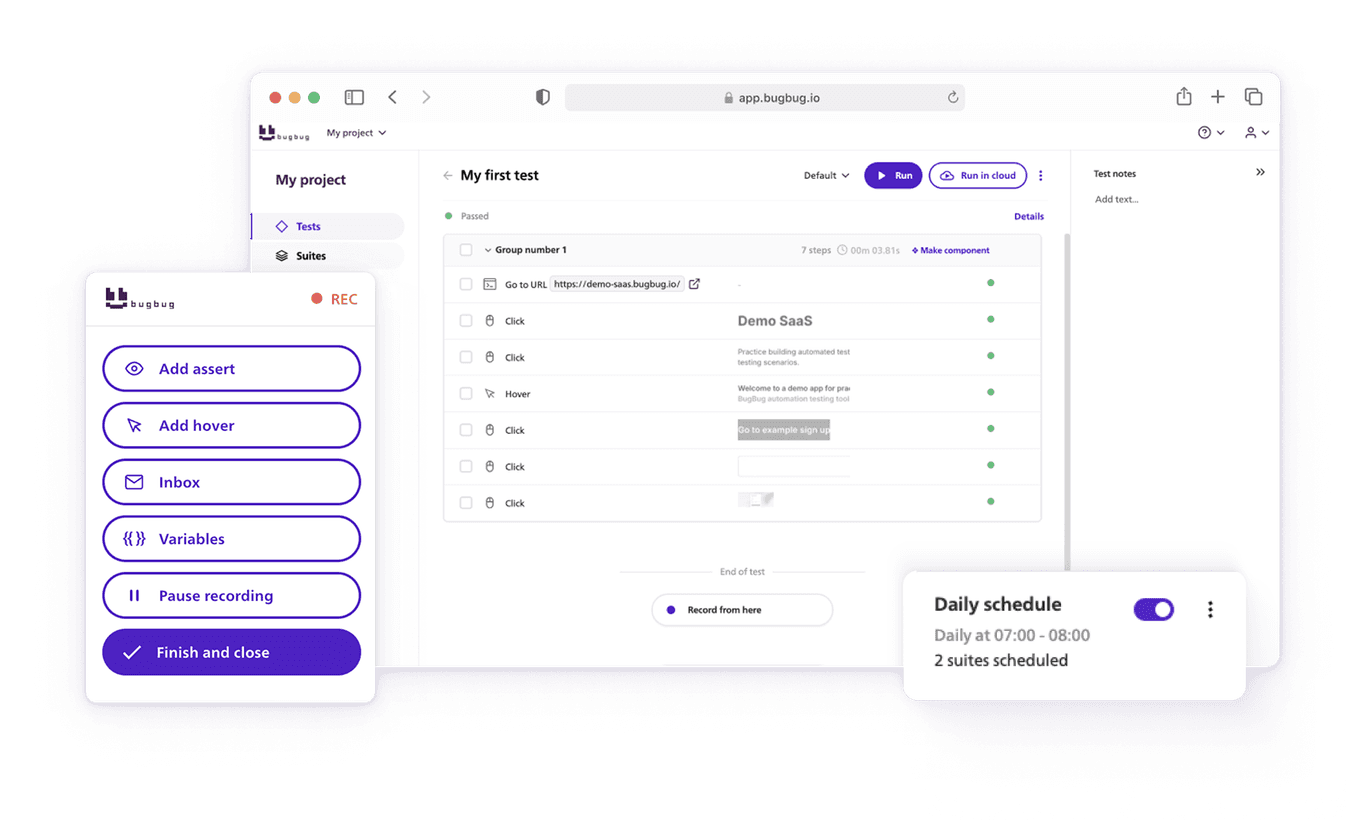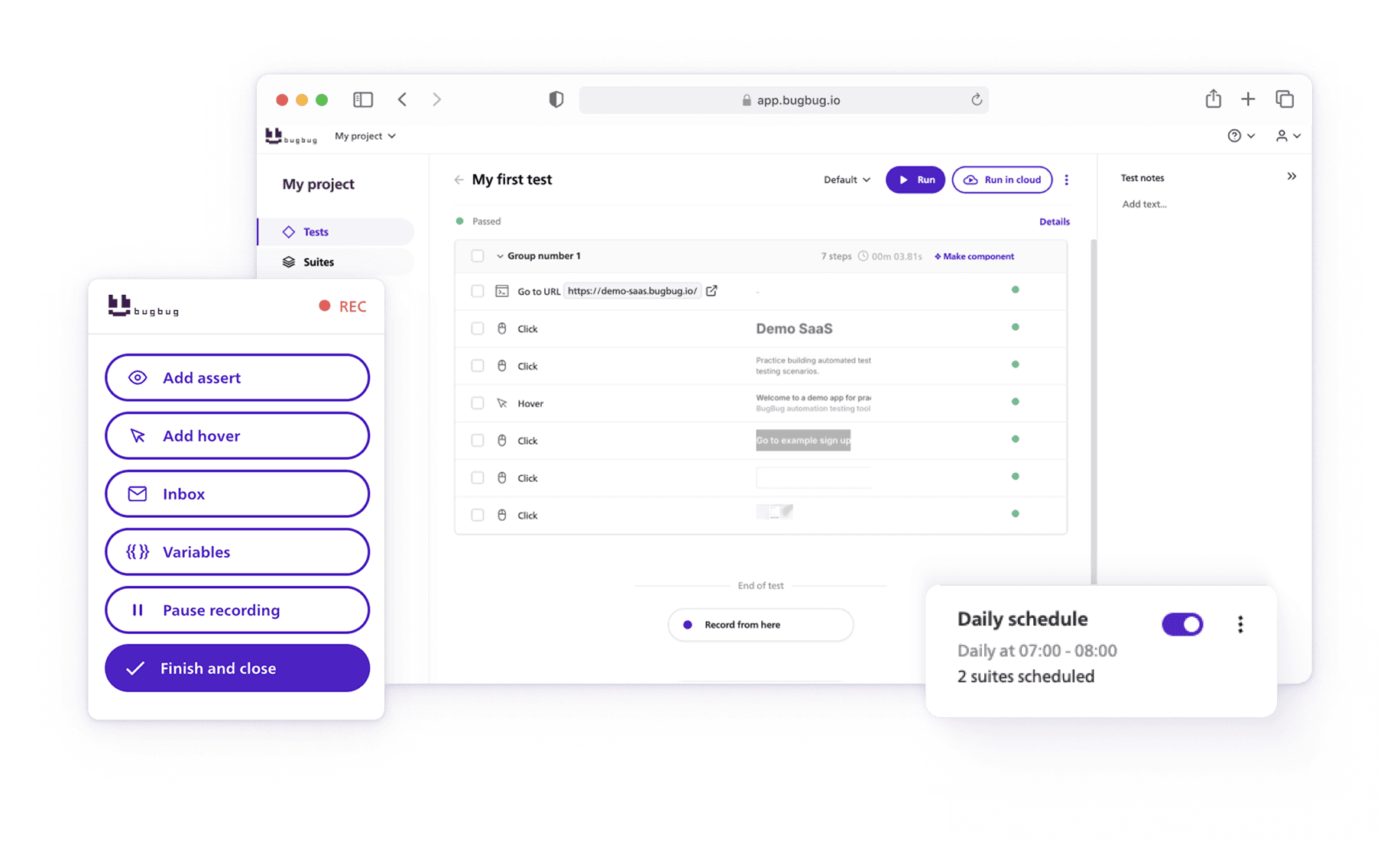🤖 Summarize this article with AI:
💬 ChatGPT 🔍 Perplexity 💥 Claude 🐦 Grok 🔮 Google AI Mode
You’ve just launched a new feature on your website after weeks of development. It looks great in your browser, but soon your support inbox lights up. Customers on mobile devices can’t complete checkout, Safari users see broken forms, and one unlucky buyer encounters a security vulnerability in your login page.
- 🎯 TL;DR - How To Start Testing Process on a Website?
- What Website Testing Involves
- Step 1: Decide What to Test First
- Step 2: Choose Manual vs Automated Testing
- Step 3: Run Core Tests
- Step 4: Automate High-Value Flows
- Step 5: Integrate Testing into Your Workflow
- Best Practices for Website Testing
- How BugBug Makes Website Testing Easier
- Conclusion: From Chaos to Confidence
- FAQ
That’s why learning how to test a website is essential for every QA testing team, developer, or startup founder. Website testing isn’t just about making sure things “work.” It’s about creating a consistent user experience across browsers, screen sizes, and operating systems, while protecting user data and ensuring your business can scale.
In this guide, we’ll cover a step-by-step web application testing guide. You’ll learn:
- The major testing types (functional, usability, performance, security, and compatibility).
- The balance between manual website testing and automated testing.
- How to design a testing strategy and write effective test cases.
- How modern automation tools like BugBug reduce testing efforts.
By the end, you’ll have a clear roadmap to build proper testing into your software development process.
🎯 TL;DR - How To Start Testing Process on a Website?
- Start with critical flows (signup, login, checkout, forms, navigation) and cover cross-browser, mobile, and backend data checks.
- Combine manual testing (exploration, usability) with automated testing (regression, core flows, CI/CD integration).
- Best practices: document a test plan, prioritize high-risk areas, fix flaky tests, and use tools like BugBug to simplify automation.
Check also:
What Website Testing Involves
Website testing (also called web testing or web app testing) refers to validating that your web application works correctly, securely, and efficiently for all users. It’s a structured testing process that ensures:
- Every feature delivers the intended functionality.
- Pages are fast, stable, and scalable.
- Data integrity is preserved in databases and APIs.
- Users enjoy a seamless user experience across browsers and devices.
Start website testing in 5 min
Test easier than ever with BugBug test recorder. Faster than coding. Free forever.
Get started
Main Testing Types in Website QA Testing
- Functional testing: Validates that features like forms, logins, and navigation work. This often involves writing test scripts and checking web pages for expected results.
- Usability testing: Focuses on ease of use and intuitive design. Does the site work well on various devices and screen sizes for mobile users and desktop users alike?
- Performance testing: Ensures your site can handle load and traffic. Includes load testing, stress testing, and parallel testing.
- Security testing: Checks for security vulnerabilities, weak points in authentication, and risks like cross site request forgery (CSRF). Includes penetration testing and secure coding practices.
- Compatibility testing: Validates that your website works across browsers, different devices, and operating systems (Windows, macOS, Android, iOS). Also called cross browser testing or cross platform compatibility testing.
- Accessibility testing: Ensures your site is usable for people with disabilities, following standards like WCAG. Screen readers, color contrast, and keyboard navigation must all work.
Together, these testing focuses give you confidence in your website’s quality.
Step 1: Decide What to Test First
Testing every pixel of your site on day one isn’t practical. Start by focusing your testing efforts on high-value areas.
Critical Functional Flows
- Signup and login – if users can’t create an account, they can’t engage.
- Checkout – the most valuable flow for e-commerce. (For more, see our e-commerce testing guide)
- Forms – test forms thoroughly (validation, error handling, correct submission).
- Search and navigation – broken links or menus frustrate users.
Coverage Considerations
- Cross browser compatibility: At a minimum, test on Chrome, Firefox, Safari, and Edge.
- Mobile devices: Cover iOS and Android, and test multiple screen sizes.
- Accessibility: Run quick checks with tools like Axe or Lighthouse to catch major issues.
Backend & Data Flows
- Database testing: Ensure data integrity when users submit forms or make transactions.
- API testing: Validate that backend services respond correctly to test requests.
👉 A written test plan outlining these flows helps your testing team stay aligned and efficient.
Step 2: Choose Manual vs Automated Testing
Both manual testing and automation testing have a role in modern QA.
Choose automation testing with BugBug
Test easier than ever with BugBug test recorder. Faster than coding. Free forever.
Get started
Manual Website Testing
Manual testing focuses on human judgment and exploratory techniques. It’s especially useful for:
- Exploratory testing – uncovering unexpected issues by thinking like a user.
- Usability testing – identifying confusing flows, broken layouts, or poor UX.
- Interface testing – evaluating visual design and responsiveness across devices.
Manual testing is flexible but doesn’t scale. Running dozens of regression checks manually before every release slows the development process.
Automated Testing
Automated testing tools shine when you need consistency, speed, and scale. They:
- Run test scripts for critical flows (login, checkout, forms) repeatedly.
- Enable continuous testing in CI/CD pipelines.
- Support parallel testing across browsers and devices.
Modern automation doesn’t require heavy frameworks. Tools like BugBug let teams automate without code, reducing the barrier to entry.
👉 The best testing strategy combines both: manual for exploration, automated for regression and routine checks.
Step 3: Run Core Tests
With your priorities clear, it’s time to execute. A proper testing process should include multiple categories:
Functional Testing
- Validate navigation menus, buttons, and forms.
- Confirm business logic (e.g., discount codes apply correctly).
- Check that all broken links are identified and fixed.
Usability Testing
- Observe real users completing tasks.
- Ensure content is easy to find and accessible.
- Verify design consistency across different devices and screen sizes.
Performance Testing
- Load testing: Simulate normal traffic to measure response times.
- Stress testing: Push beyond capacity to identify weak points.
- Parallel testing: Check performance when multiple users interact at once.
Security Testing
- Check for web security risks like SQL injection or CSRF.
- Perform penetration testing to identify vulnerabilities.
- Validate that your web server and database are configured securely.
Compatibility Testing
- Run cross browser testing on major browsers.
- Test on mobile devices and tablets.
- Validate cross platform compatibility for different OS.
Accessibility Testing
- Test with screen readers.
- Ensure proper ARIA roles and alt text.
- Verify keyboard navigation works.
Covering these areas gives your site a foundation for a seamless user experience.
Step 4: Automate High-Value Flows
As your testing efforts grow, automation testing becomes crucial. Focus on automating:
- Core functional flows (login, checkout, form submission).
- Regression tests to prevent old bugs from returning.
- API testing for backend stability.
Test automation also supports:
- Continuous testing in your development process.
- Parallel testing across browsers for speed.
- Scaling your testing team’s output without adding headcount.
Automation Tools
- Traditional frameworks: Selenium, Cypress, Playwright. Require coding and setup.
- Codeless automation tools: BugBug, which eliminates infrastructure complexity.
BugBug advantages:
- Record tests without writing code.
- Free forever for local runs.
- Built-in email testing and database testing support.
- Works with CI/CD for continuous testing.
Step 5: Integrate Testing into Your Workflow
Testing should never be an afterthought. It needs to be part of your software development lifecycle:
- CI/CD pipelines: Run regression tests on every pull request.
- Scheduled runs: Nightly checks ensure long-term stability.
- Continuous testing: Detect issues earlier in the cycle, not just before release.
- Notifications: Share failures with devs and PMs via Slack or email.
This makes testing proactive, not reactive.
Best Practices for Website Testing
- Start with a written test plan: Document your testing strategy, test cases, and priorities.
- Balance testing techniques: Mix manual exploration with automation frameworks.
- Prioritize high-risk areas: Protect revenue-critical flows like checkout.
- Fix flaky tests quickly: Unreliable test scripts undermine trust.
- Use crowd testing when needed: For real-world feedback on usability and performance.
Following these practices ensures proper testing and a stronger user interface for your web applications.
How BugBug Makes Website Testing Easier

BugBug is designed for small-to-medium teams who need powerful automation tools without the overhead of a heavy automation framework.
- Free forever plan: Record unlimited tests and run them locally at no cost.
- Cloud runs & scheduling: Automate regression testing at scale.
- Zero infrastructure: No Selenium grids, no Docker, no VMs.
- Advanced testing features:
- Built-in email and API testing.
- Support for complex web applications.
- Integrations for Slack and CI/CD.
For startups and agile teams, BugBug removes the barrier between web development and reliable testing.
Conclusion: From Chaos to Confidence
Testing websites isn’t just about finding bugs — it’s about protecting your users and your business.
By combining manual website testing with automated testing, covering all key testing types (functional, performance, usability, security, compatibility, accessibility), and integrating testing into your development process, you ensure a seamless user experience for every visitor.
👉 Ready to start? Try BugBug for free and set up your first automated tests today.



